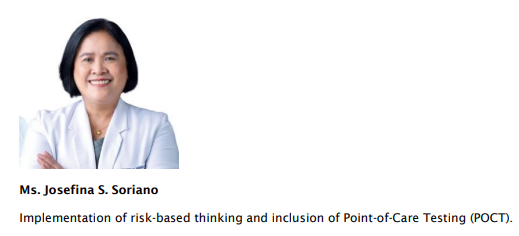Expert Interview-Clinical Lab Accreditation ISO 15189:2022 & its Implementation Strategies
Prof. Pradeep Kumar Dabla, Prof. Tony Badrick
Moderator & Corresponding Author(s): 1. Prof. Pradeep Kumar Dabla, Department Biochemistry, G.B.Pant Institute of Postgraduate Medical Education & Research (GIPMER); NABL Quality Council of India, Lead & Technical Assessor Medical Laboratories ISO 15189:2022 & PTP ISO 17043:2023, INDIA; pradeep_dabla@yahoo.com
2. Prof. Tony Badrick, CEO The Royal College of Pathologists of Australasia Quality Assurance Programs (RCPAQAP), AUSTRALIA; tony.badrick@rcpaqap.com.au
APFCB News Volume 4, Issue 2, 2025
Introduction
This is a new section of the APFCB New where we will invite experts in a particular topic in laboratory medicine to answer some practical questions.
We have started with ISO 15189, the most widely recognised medical laboratory standard, and one many countries in the Asia-Pacific region use. The importance of using a common, independently written by international experts cannot be overemphasised, and even though many laboratories may not be able because lack of resources, to be accredited against the Standard, it serves as a model that all clinical laboratories should follow.
The three fundamental factors that lead to improvement in healthcare, and most other human endeavours, are (a) technical/equipment/automation, (b) process management, and (c) operator competence. ISO 15189 provides the requirements for the specific management of clinical laboratories. The latest version includes more emphasis on the competence of the humans in laboratories, a key area where there will be improvements for patient outcomes.
ISO 15189 which is based on ISO 17025:2022 General requirements for the competence of testing and calibration laboratories was first published in 2003. It has been revised in 2007 to align more closely to ISO/IEC 17025. A third edition of the standard was published in 2012, which revised the layout again and added a section on laboratory information management.
The 2022 version differs from the 2012 edition in several areas including the following.
- A realignment with the latest version of ISO/IEC 17025:2017 in terms of structure and approach.
- There are now requirements for POCT included as an Appendix which were previously in ISO 22870.
- There is a move away from a compliance standard to an increased emphasis on risk management, particularly a greater focus on clinical risk and the impact of services on patients.
- There is a much greater focus on laboratory management and personnel.
The expert group identify key changes with the 2022 edition of ISO 15189, how laboratories should adopt risk-thinking, what are the new expectations of staff training and competence assessment and using AI tools.
Questions: 1.
What key changes in ISO 15189:2022 must labs prioritize?
Prof. Tomas Zima
The ISO 15189:2022 revision introduced significant updates to align with modern quality management principles, increased digitalization, and greater emphasis on risk and competence and less perceptive. The 2022 version aligns more closely with other ISO standards to support integration in multi-disciplinary labs. Requirements for point-of-care testing (POCT), previously in ISO 22870, have been incorporated. Risk-based thinking is embedded throughout the standard, replacing the older emphasis on preventive action. Competency is now explicitly tied to specific tasks and roles, not just education or job title. Labs should prioritize the changes that impact quality, safety, and compliance most directly with more emphasis on patient safety, result interpretation, and communication
Dr. Marissa A. Orillaza
External quality assessment in ISO 15189:2022 is one of the changes that needs prioritization. It allows the medical laboratory to use a wide range of techniques aside from the usual simple participation in the proficiency testing or survey either given at the national or international level. POCT is also another key change with limited approach which has been introduced and very popularly being accepted in modern world. Lastly, advanced automation is widely used by big hospital laboratories from pre-examination to postexamination that increases the risk of legal problems. Careful attention should be placed on cybersecurity.
Dr. Sarah Jane L. Datay-Lim
Laboratories must prioritize integration of risk-based thinking, shifting the culture of the laboratory into something that is proactive rather than reactive. The potential risks must be identified and this must be integrated into the quality management system and the decisionmaking process (from equipment selection to staffing). This would also benefit patient welfare and safety which is also contributes to the requirement for increased patientcentered care.
Dr. Paulo Enrico P. Belen
In some standards that might need some level of prescriptiveness to meet the requirements
it might be better to add some degree of prescriptiveness.
Not all laboratories are capable of buying CLSI standards to review the best practice to meet each area of the standards.
POCT as part of laboratory medicine services is included in the scope of ISO 15189: 2022. Therefore, the whole ISO 15189 standard applies to POCT, as for any lab-based test. It specifies the laboratory’s responsibility towards the selection of devices, training personnel, quality assurance and management review of the complete POCT process. There must be service agreements between laboratory and other parts of the organization using POCT. The laboratory should appoint a person who will be responsible for POCT quality and to manage training and competency assessment of personnels performing POCT.
In ISO 22870:2016 manufacturer’s recommendations regarding minimum quality control of an instrument may be accepted following documented review and an instrument-generated quality control shall be acceptable provided that regulatory authorities have accepted it. However, in ISO 15189:2022 IQC shall be performed at a frequency that is based on the stability and robustness of the examination method and the risk of harm to the patient from an erroneous result. Method comparison should be performed among POCT instruments and with central laboratory equipment throughout the clinically significant intervals. As with other tests performed by different methods or in different location, user should be aware of the discrepancies.
2. How can labs apply risk-based thinking effectively?
Prof. Tomas Zima
Applying risk-based thinking effectively in laboratories under ISO 15189:2022 means integrating proactive risk identification, evaluation, and control into all aspects of lab operations—not just reacting to errors after they happen. ISO 15189:2022 emphasizes preventive actions over corrective actions. Identify and Prioritize Risks and ask: What could go wrong? What is the likelihood of it happening? What would be the impact on patient care or data quality? And use a simple risk matrix – risk level (low, medium, high) and Likelihood x Severity (rare error, low impact, occasional, moderate impact, likely or serious consequences). Labs should focus on the most effort on high-likelihood, high-severity risks and tailor risk controls to the severity and frequency of the risk.
Dr. Marissa A. Orillaza
Medical laboratories that are ISO-9001 certified do not have difficulty applying risk-based thinking in the quality management part of ISO 15189:2022. They can use 5 steps: 1. Identify potential problems or risks before they occur in the 3 phases of examination, taking note of the likelihood and impact on conformity. 2. Implement actions to be taken 3. Regular monitoring and analysis of its effectiveness 4. Risk evaluation, which is the best part of this activity that results to quality improvement. However, before this can happen, risk awareness culture should be in place.
Ms. Josefina S. Soriano
By identifying risks across all laboratory processes, prioritizing high-risk areas, assessing their impact, implementing appropriate control, monitoring outcomes and documenting all risk management activities.
Dr. Sarah Jane L. Datay-Lim
Risk-based thinking can be applied effectively by first identifying the risks using tools that fit their needs (such as SWOT, FMEA or risk registers) and then start analysis of the different sections and laboratory processes from pre-analytic to post analytic. I think this can be more effective if they integrate it into their daily operations rather than doing it for compliance only. This way, laboratories may truly benefit from risk-based thinking because the culture of awareness and accountability is nurtured and operational efficiency is also increased.
Dr. Paulo Enrico P. Belen
Labs can apply risk based effectively if they seriously apply the entries in the risk analysis matrix. Some laboratories just enter the items for compliance purposes
Tjan Sian Hwa
Risk based thinking should be part of laboratory culture and implemented in every laboratory process. The laboratory should have a system that encourage every staff to identify and manage potential risks on patient care in the pre-examination, examination and post-examination processes. This system should be consistently reviewed and updated. Laboratory personnel should be taught how to evaluate the risk with Failure Mode Effect Analysis. Laboratory staff should be able to assess and mitigate risk (by avoiding threat, eliminate risk source, reduce the risk, transfering risk, taking a risk for an opportunity for improvement, or accepting risk by informed decision) and monitor the effectiveness of the mitigation processes with Plan Do Check Action (PDCA). The laboratory should appoint a person to ensure the whole risk management process is implemented. It is a continuing process; thus, the commitment of the higher management level is very essential.
3. What are the new expectations for staff training and competence?
Prof. Tomas Zima
Under ISO 15189:2022, the expectations for staff training and competence have been expanded and clarified to reflect the growing complexity of laboratory work, especially with the integration of technologies like AI, RPA, and advanced informatics systems. ISO 15189:2022 shifts from checking educational credentials to demonstrated, role-specific competence. Competency should be proven through observation, assessment, or audit and training should align with the actual tasks performed—not just job titles. Competency is not a one-time event—it should be assessed regularly. Competency checklists should include both technical and behavioral aspects (e.g., problem-solving, effective communication with patients and clinicians) with new focus on soft skills, especially around patient confidentiality, ethical responsibilities, team coordination, and error disclosure.
Dr. Marissa A. Orillaza
The new expectations for staff training and competence are: 1. The internal and external training will be checked regularly for its effectiveness 2. The staff should be qualified to train for the position with regular performance evaluation 3. The staff should be competent to do the specific responsibilities assigned to them and checked during internal audit and external audit. 4. The staff's competency and authorization are monitored
Ms. Josefina S. Soriano
Staff must be trained in risk-based thinking, understand their role in maintaining quality and the risk register and undergo regular competency assessments.
Dr. Sarah Jane L. Datay-Lim
I think for staff training and competence, it must be an ongoing process with periodical assessments rather than just one-time training. They must be evaluated not just by examination but also other tools such as observation, practical or simulated exercises. It must be tailored to the role of the staff, specific duties and responsibilities and must be varied depending on the complexity of the work that they do. New methods available such as the use of technology can be utilized to help in the training (digital materials, etc.).
Dr. Paulo Enrico P. Belen
For the 2022 version compared to the previous version I think the new expectations are more job specific training and competence compared to the previous versions that are more generalized.
Tjan Sian Hwa
The laboratory shall ensure all personnels to have the competence to perform laboratory activities of which they are responsible. First, the laboratory shall specify the competence framework for each function (education, qualification, training, re-training, technical knowledge, skills, and experience) and ensure the competency by having a process for competence assessment by among others direct observation of an activity, monitoring the recording and reporting of examination results, review of work records, assessment of problem-solving skills, and examination of specially provided samples. The ongoing staff competency should be monitored and documented
4. How should labs validate RPA (robotic process assessment) and AI (artificial intelligence) tools under ISO 15189?
Prof. Tomas Zima
Validating Robotic Process Automation (RPA) and Artificial Intelligence (AI) tools under ISO 15189:2022 requires a structured and risk-based approach, ensuring that these tools consistently produce accurate, reliable, and clinically relevant results. While ISO 15189 does not explicitly name RPA or AI, its principles for validation, verification, and risk management of laboratory processes apply to these technologies. Lab should define the task the tool performs and Its impact on patient results or clinical decision-making. For AI and RPA tools define performance specifications (e.g., accuracy, sensitivity, specificity for AI e.g. compare AI output with a gold standard or human expert interpretation) and acceptable outcomes for process efficiency and error rate (RPA e.g. confirm that automation performs tasks correctly, simulate interruptions or errors and assess recovery logic). AI models and RPA need to set triggers for revalidation (e.g., software updates, changes to input data structure).
Dr. Marissa A. Orillaza
RPA is a technology that uses new and advanced software to automate repetitive processes within digital workflows to achieve higher productivity, accuracy, and precision. Similar to other processes that are manually done, this can validate RPA and AI by checking their: 1. defined objectives 2. Assessment and analysis of the chosen process.3. if there is multicollaboration of IT, management, and operation team for client’s satisfaction 4. if the right tools are used with vendor support 5. if the staff are prepared with training for continual improvement 6. if there is nonconformity to change
Ms. Josefina S. Soriano
Laboratories must validate RPA and AI tools in accordance with ISO 15189:2022, ensuring they meet requirements for accuracy, quality, traceability and patient safety.
Dr. Sarah Jane L. Datay-Lim
Laboratories can validate RPA and AI by ensuring that there is someone qualified in the laboratory assigned to monitor and maintain human oversight. Although this is quite new to us and a lot of laboratories in the Philippines may not have these available currently, we can prepare by ensuring that all processes are traceable. We must put in place policies to safeguard safety, requiring that there must be logs, documentation and that it can be audited easily.
Dr. Paulo Enrico P. Belen
Resources are always scarce, especially in third world countries. So I think the risk based approach is a practical way of doing it so that we will be able to prioritize where to focus the limited resource.
Tjan Sian Hwa
A process is a set of interrelated or interacting activities that use inputs to deliver an intended result. Inputs and outputs may be tangible (e.g. materials, components or equipment) or intangible (data, information or knowledge). An output of a process can be an input for the next process. We can use the Plan Do Check Action cycle for each process. Starting with planning the process, identify all the required and the availability of resources for each process, identify the required output and determine the quality indicator of each process (PLAN). Perform the process (DO) and monitor and evaluate the process implementation and output (CHECK) and do the corrective action (ACTION).
Concluding remarks
The aspects of clinical laboratories discussed by the experts in this article are those places where patient safety is compromised. We all need to focus on staff and patient risk, staff competence and the opportunities and risks of using AI, which has already become an essential, if uncontrolled, part of our daily life.
Experts Curriculum Vitae:
1. Prof. Tomáš Zima, MD, DSc, is a distinguished medical biochemist who graduated from the First Faculty of Medicine, Charles University, in 1990. He has served as Professor and Head of the Institute of Medical Biochemistry and Laboratory Medicine since 2001. He was Dean (2005–2012) and later Rector (2014–2022) of Charles University, and a visiting professor at Università degli Studi di Milano in 2024. His research spans oxidative stress,
AGEs, experimental nephrology, tumour markers, and laboratory management. He authored over 550 publications and 10 books, he holds leadership roles in major scientific bodies, including President-Elect of EFLM (2024–2025).
2. Dr. Marissa Orillaza, an accomplished Anatomic and Clinical Pathologist, graduated from FEU-NRMF in 1981 and earned recognition as Most Outstanding Intern in 1982. She is Head of Laboratory Medicine at Tagaytay Medical Center and two Unihealth hospitals, and a founding Board Member of ACE Group of Hospitals. Actively engaged in quality management, she has led ISO/IMS certification initiatives and served as Vice-Chair of the DTI-PAB ISO 15189 Committee. A past president of PSP, PCQACL, and ANCLS, she also chaired national trainings. Beyond medicine, she co-founded SLDC, supporting students in Laguna, and advises The Solid Truth, Inc.
3. Ms. Josefina Soriano, BS Medical Technology (University of Santo Tomas), is the Chief Medical Technologist at the National Kidney and Transplant Institute (NKTI), a leading National Reference Laboratory in the Philippines. Under her leadership, NKTI became the first government laboratory in the country to attain ISO 15189 accreditation, marking a significant milestone in national laboratory standards. A respected authority in clinical laboratory quality, she serves as Treasurer of the Philippine Council for Quality Assurance in Clinical Laboratories (PCQACL). She is also a sought-after speaker and senior auditor, widely recognized for her expertise in ISO 15189 and quality management systems.
4. Dr. C. Sarah Jane L. Datay-Lim, MD, FPSP is a Laboratory Quality and Safety Consultant Director at The Medical City. She also holds the position of past president and current chair of the Committee on Education, Training and Research for the Philippine Council for Quality Assurance in Clinical Laboratories (PCQACL). She is a Doctor of Medicine and a Fellow of the Philippine Society of Pathologists.
5. Dr. Paulo Enrico P. Belen? is a graduate of the University of Santo Tomas with a Doctor of Medicine degree. He completed his residency in Pathology at St. Luke’s Medical Center – Quezon City, where he now serves as Assistant Chair of the Institute of Pathology in both the Quezon City and Global City hospitals. A past president of the Philippine Council for Quality Assurance in Clinical Laboratories (PCQACL), he has long been active in education and training. Dr. Belen is also a certified ISO 15189 auditor and has completed multiple trainings in laboratory quality systems and management.
6. Dr. Tjan Sian Hwa, MSc, MD is a distinguished Clinical Pathologist with a strong background in laboratory medicine, tropical diseases, and quality systems. She earned her medical degree and specialization in Clinical Pathology from the University of Indonesia and holds a Master of Science in Clinical Tropical Diseases from Mahidol University, Thailand. She currently serves as Head of the Clinical Laboratory Department at Premier Jatinegara Hospital and Laboratory Director of Westerindo Private Medical Laboratory in Jakarta. Dr. Tjan is President of the Indonesian Association for Clinical Chemistry, Chair of the APFCB Laboratory Management Committee, and a Lead Assessor for ISO 15189.
Authors Contribution: All authors are independent experts and equally contributed to the expert interview article published.
Funding: None declared
Conflict of Interest: None declared??????


.PNG)



